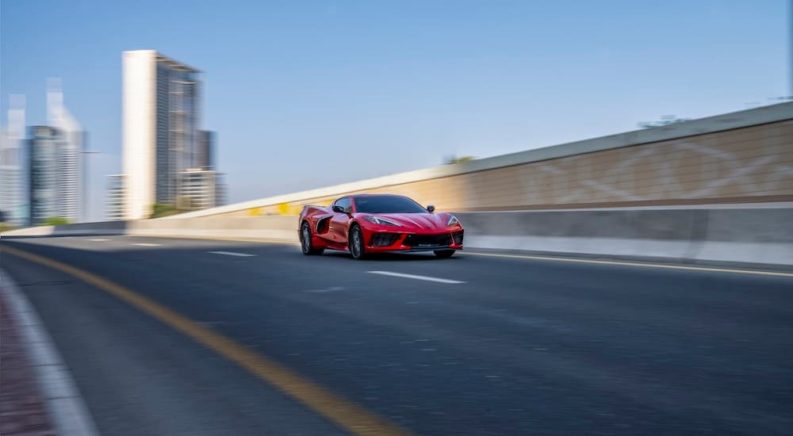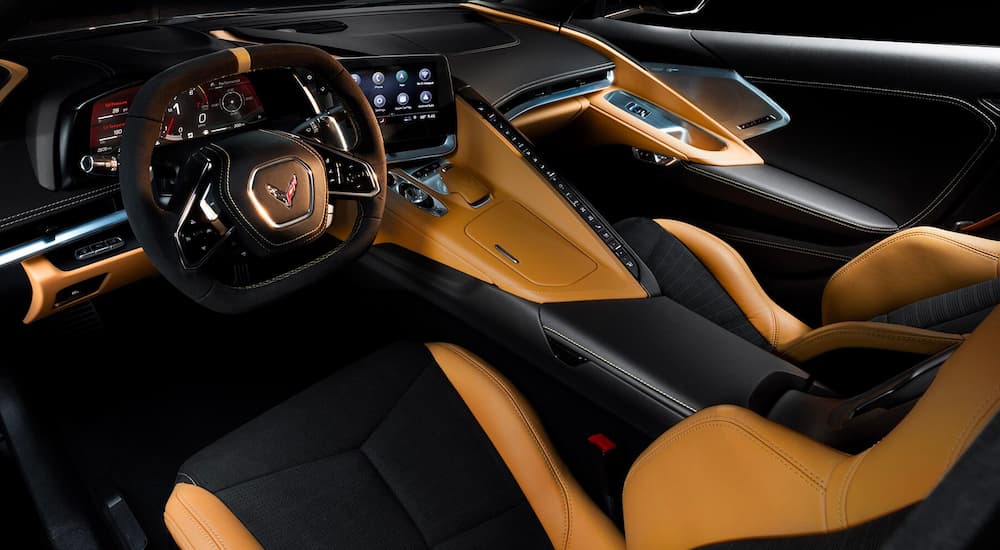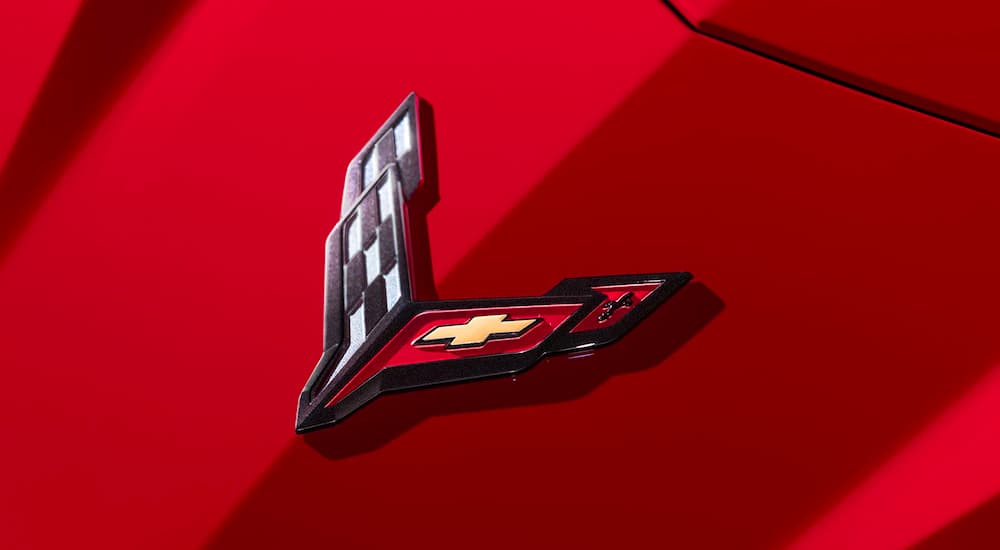Generally speaking, making a new vehicle is a team effort. Designers, engineers, marketing staff, technicians, and production line staff all work together to bring each new model into existence in a process that usually takes between three to five years. That said, there are some exceptions to the rule and some game-changing automotive minds who, through experience, vision, and sheer determination, have managed to bring something truly unique to the market.
Credited as the “Father of the Corvette,” Zora Arkus-Duntov is one such man. While the Russian émigré didn’t actually invent the Corvette itself, his experience in the world of engineering and high-performance endurance racing made the legendary sports car a reality. As the automaker prepares to release the 2023 Chevy Corvette Stingray, we thought it would be the perfect time to look back on the model’s origin, Arkus-Duntov’s influence, and see how this iconic American sports car came to be. We’ll also see what’s new for 2023 when it comes to the latest iteration of the Corvette Stingray, so sit back, buckle up, and join us as we take a lap through history.
Earning His (Racing) Stripes
The Corvette hit the streets in 1953, but to truly understand the storied sports car, you have to travel a little further back to 1909. Zora Arkus-Duntov grew up in Saint Petersburg but moved to Berlin when he was still a small boy. The son of an electrical engineer, Arkus-Duntov’s fascination with all things motorized was evident from an early age when the boy first dreamed of being a streetcar driver. As he grew up, Arkus-Duntov would trade his streetcar ambitions for a higher-octane form of automotive fun, starting with motorcycles before moving on to the safer alternative of automobiles at his parent’s insistence. After graduating with an engineering degree from the Technical University of Berlin, Arkus-Duntov contributed articles to German motor publications before the outbreak of World War II led him to join the French Air Force.
When France surrendered, Arkus-Duntov’s family decamped for the U.S., where the engineer and his brother wasted no time in setting up their own company, Ardun Mechanical Corporation (AMC). The company initially produced punches and dies for ammunition and later aircraft parts, but it was Arkus-Duntov’s experiments with the flathead Ford V8 engine that would set the stage for things to come. AMC rolled out their own line of overhead valve aluminum cylinder heads for the popular engine in 1947 in a bid to address one of the most common complaints around the valve-in-block Ford engine: overheating. AMC’s innovative overhead design solved the pesky temperature issue, allowing engineers to squeeze significantly more horsepower out of the V8 and making Arkus-Duntov a name to watch out for in the industry.
Arkus-Duntov’s next stop was London-based Allard Motor Company, where he was brought on to help develop a car for the 24 Hours of Le Mans endurance race. While at Allard, Arkus-Duntov not only perfected the Ford V8-powered Allard sports car but also drove it at Le Mans as a team racing driver in 1952 and 1953. Arkus-Duntov was in good company behind the wheel of the Allard sports car, a different version of which was also driven at Le Mans by automotive design legend Carroll Shelby. Arkus-Duntov would jump ship for Porsche in ‘54 and ‘55, earning class wins in the Porsche 550 RS Spyder.
A Visionary Meets an Icon
Just to be clear, Arkus-Duntov didn’t invent the Corvette––that honor goes to Harley Earl––but he is credited with perfecting the sports car. It was actually the Corvette that brought the engineer to General Motors in the first place. By 1953 Arkus-Duntov was a rising name in the industry with no shortage of offers from major automakers, but it was a fateful trip to the Motorama auto show that would bring him to GM. It was there that Arkus-Duntov first saw the Corvette, which was brand new that year. While Arkus-Duntov was won over by the car’s sporty, futuristic appearance, he was underwhelmed by what he found under the hood. The Corvette certainly cut a striking figure, using a 55-degree raked windshield and a never-before-seen glass fiber-reinforced plastic chassis that dramatically increased the car’s power-to-weight ratio, but that’s where the innovation stopped.
The early Corvette featured the same inline six-cylinder engine, two-speed automatic transmission, and drum brakes as many other Chevy models of the time despite the inclusion of a high-performance triple carburetor system. Shortly after the Motorama show, Arkus-Duntov wrote a letter to Chevrolet chief engineer Ed Cole in which he laid out a method for testing the car’s top speed. By May 1, Arkus-Duntov was an assistant staff engineer at Chevy, and while the Corvette wasn’t exactly in his purview, he never stopped dreaming of ways to perfect the sports car.
Despite some initial excitement, Corvette sales were faltering by 1955, putting the model’s future in doubt. Chevy needed some inspiration, and it needed it fast, but luckily Arkus-Duntov was on the job. The engineer submitted a paper to the GM brass titled “Thoughts Pertaining to Youth, Hot Rodders and Chevrolet” in which he argued that the introduction of a powerful V8 could go a long way in improving Chevy’s profile amongst auto races and customizers. The paper earned Arkus-Duntov a new job title: Director of High-Performance Vehicles, and the rest is history. Under Arkus-Duntov’s direction, Chevy introduced its first V8 engine since 191––a 4.3-liter small-block V8 that churned out 195 horsepower, gave the Corvette a serious upgrade, and cemented its place in automotive history. Of course, the engineer can’t take all the credit––GM was also eager to introduce a rival for Ford’s Thunderbird, and the upgraded Corvette fit the bill––but there’s no denying Arkus-Duntov’s influence.
Despite his success with the Corvette, Arkus-Duntov wasn’t content to rest on his laurels or sit behind a desk, for that matter. In 1956 he took the sports car to Daytona Beach, where he set a record flying mile speed of 150 mph. Back at GM, Arkus-Duntov would continue to innovate, designing a high-lift camshaft, introducing fuel injection to the Corvette in 1957, and helping to produce the first-ever American production car with four-wheel disc brakes. While Arkus-Duntov wasn’t intimately involved with the C2 Corvette “Sting Ray” model––the forerunner of the modern Corvette Stingray––he did provide some input, namely trashing the sports car’s long hood and the full-length winsplit that divided the back window into two sections.
Arkus-Duntov would continue to perfect the Corvette during the rest of his career at GM, first with the Corvette SS and later with the Corvette Grand Sport. The SS, along with the Q Corvette project, would actually provide the blueprint for early Stingray Corvette models, though a full-on production version wouldn’t be released until 1963. The racing-focused Corvettes were a bit of a flash in the pan, with neither model finding widespread success, though that was partially due to GM’s increasing lack of disinterest in the world of motorsport spurred by a deadly accident in 1955 at the Le Mans race.
Arkus-Duntov did manage to sneak a few of the discontinued Corvette Grand Sport models to close friends, who would find some brief success with the souped-up Corvette. At the Nassau Trophy race, all three Grand Sport models scorched the competition by ten seconds, including a Shelby Cobra and Ferrari GTO. One of the last remaining Corvette Grand Sport models, chassis #002, was auctioned off in 2009 for $4.9 million.
Arkus-Duntov would be named Chief Engineer for Corvette in 1967 and stay with the company until his retirement in 1975. While his career was behind him, Arkus-Duntov would be inexorably linked to the Corvette until his death, helping to roll out the one-millionth model in 1992 and driving the bulldozer that broke ground on the National Corvette Museum––where his ashes were later scattered––in 1994.
An Update on the Classic
That brings us to the 2023 Chevy Corvette Stingray. While the “Stingray” first debuted on the second-gen Corvette in 1963, GM dropped the name following the 1977 model year. The moniker would return as part of the Corvette’s seventh generation in 2014 and is still used today as part of the eighth generation. Today, all Corvettes are split into two distinct models: the Stingray and a high-performance version known as the Z06.
Powered by a new version of GM’s 6.2-liter V8, the 2023 Corvette Stingray would undoubtedly make Arkus-Duntov proud. The naturally aspirated engine outputs an impressive 490 horsepower and 465 lb-ft of torque, which is a significant improvement over the previous seventh-generation model. Drivers looking for a little extra power can always spring for the Z51 package, which adds five horsepower to the mix, as well as an electronic limited-slip rear differential, a third radiator, upgraded brakes, and summer tires. In its most high-performance guise, the Corvette can speed from zero to 60 mph in just 2.8 seconds, which is especially impressive given the sports car’s relatively modest price point. The eighth-gen Corvette is the first to feature an eight-speed dual-clutch transmission, which can be controlled via a push-button gear selector or steering wheel-mounted paddle shifters.
Innovation has always been a big part of the Corvette story, and Chevy is making sure that continues to this day with the latest model. The sports car is built with a unique unequal-length double wishbone suspension, which goes a long way in improving the Corvette’s handling and road dynamics. Monotube shock absorbers and GM’s Magnetic Selective Ride Control make for a comfortable ride, and the model can even be optioned with a front-axle lifting height adjustable suspension system that allows the Corvette to gain two inches of ground clearance when the speed is kept under 25 mph.
Of course, as Chevy’s flagship sports car, the Corvette is packed with all the high-tech bells and whistles one would expect. From an eight-inch infotainment screen running Chevy’s Infotainment 3 Plus system to a 4G hotspot, 14-speaker Bose audio system, and over-the-air software updates, the Corvette sure has come a long way from that Motorama show over a half-century ago. On certain trims, there’s even an available Performance Data Recorder, which allows drivers to review, share and gain all-important social media clout for their driving exploits. While this type of technology isn’t what usually draws drivers to a vehicle like the Corvette in the first place, it’s sure a nice add-on that brings the famous sports car firmly into the modern era.
A True American Success Story
From the earliest concept model back in the early ’50s to the all-new 2023 version, the Corvette is a true American success story, and a lot of the credit has to go to Zora Arkus-Duntov. While Chevy was ready to give up on the sports car after a disappointing debut, Arkus-Duntov saw the impact that a properly V8-powered version of the Corvette could have on the industry as a whole. Chevy’s champion of the V8, Arkus-Duntov’s name might not be well-known to the wider world, but his vision and commitment to high-performance engineering can be felt by every driver who has ever found themselves behind the wheel of a Corvette.
The 2023 Corvette Stingray carries on that proud tradition of engineering excellence, making gearheads swoon every time they hear the rumble of that V8 engine. Of course, that might not be the case for long. GM has announced plans to transition its entire gas-powered lineup by 2035 to make way for an all-electric future, but fear not Corvette fans. Chevy has already announced a forthcoming all-electric version of the Corvette to hit the market in 2024. While it might lack the current version’s throaty roar, it’ll make up for it by being the first Corvette with all-wheel drive and boasting a zero-to-60-mph time of 2.5 seconds to boot.






